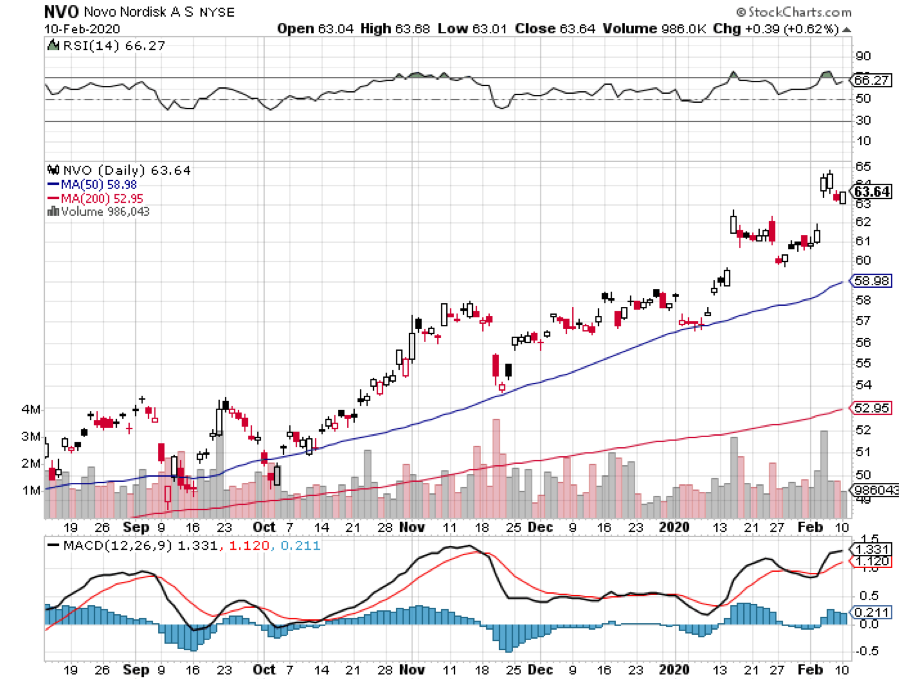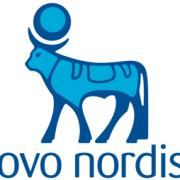Diabetes is one of the fastest-growing and serious health conditions that affect the lives of over 50% of Americans, with 60 million more categorized as pre-diabetics. As expected, the market for diabetes treatments is saturated.
However, this biotechnology company has been hailed as one of the leaders in this sector: Novo Nordisk (NVO).
Novo Nordisk has long established itself as a major player in this lucrative market, with diabetes treatments in its portfolio primarily responsible for the 24% jump of the stock’s performance in 2019 -- an increase that has been sustained up until today.
The company’s lineup includes a number of insulin products such as Tresiba and NovoRapid, with Novo Nordisk supplying roughly 50% of the insulin distributed globally.
Meanwhile, its top-selling Type 2 diabetes drug Ozempic ranked first among all the drugs launched in 2018.
Capitalizing on the success of Ozempic as a blockbuster insulin injectable, Novo Nordisk has gained FDA approval to market this bestselling drug as a treatment to reduce the risk of major adverse cardiovascular (CV) condition among patients of Type 2 diabetes.
This is actually an impressive move since diabetics are more often than not also suffering from other comorbidities like kidney problems, obesity, and CV disease.
With this expanded indication involving CV risk reduction, Novo Nordisk’s cash cow will be on par with heavyweights like Bristol-Myers Squibb (BMY) and AstraZeneca’s (AZN) Farxiga as well as Boehringer Ingelheim Pharmaceuticals, Inc. (BIPI) and Eli Lilly’s (LLY) Jardiance.
Ozempic, which was first approved way back in December 2017 as a diabetes medication and launched in the market by 2018, has long been considered the company’s strongest moneymaker.
In fact, the first nine months of 2019 saw Ozempic bring in roughly $1 billion in sales worldwide.
Still riding the momentum of its diabetes treatments, Novo Nordisk also recently received another label upgrade that classifies its recently approved oral tablet Rybelsus as CV safe as well. Projected sales for this drug now lands somewhere between $2 billion and $5 billion.
In addition to CV diseases, Novo Nordisk has also enjoyed success on other fronts like obesity.
For instance, the company’s prescription weight loss shot Saxenda has been gaining sales momentum since its release in 2014.
The fact that Saxenda can also help improve blood sugar levels for pre-diabetic patients has made it the first of its kind across the globe.
Earning $540 million in 2018, which represented a 50% jump from its 2017 sales, Saxenda is estimated to own a 68% share of the obesity market.
Saxenda’s dominance was once again proven in its third-quarter earnings report in 2019 when the drug gained an impressive 56% increase compared to the same period in the previous year.
Novo Nordisk shares come with a bit of a steep price though, and investors are hesitant over the strong reliance of the company on its diabetes lineup. After all, 84% of its sales in the third quarter of 2019 came from this line of business alone.
However, the recent approval and expanded indication of Rybelsus as another groundbreaking Type 2 diabetes treatment both in the US and abroad makes Novo Nordisk a highly coveted investment.
Keep in mind that over 90% of diabetes cases fall under that type, so the company is poised to dominate not only a lucrative sector but also an addressable target market.
Apart from that, the early and mid-stage pipeline of Novo Nordisk offers a promising lineup.
The company has been consistent with its strategy, and that is focusing on its strengths then building on them. Right now, Novo Nordisk has a lot of up and coming candidates not only for its tried and tested diabetes market but for rare diseases as well.
Thus, Novo Nordisk sales are expected to continue its upward trajectory in 2020. If this trend continues, the company can double its earnings practically every five years.



